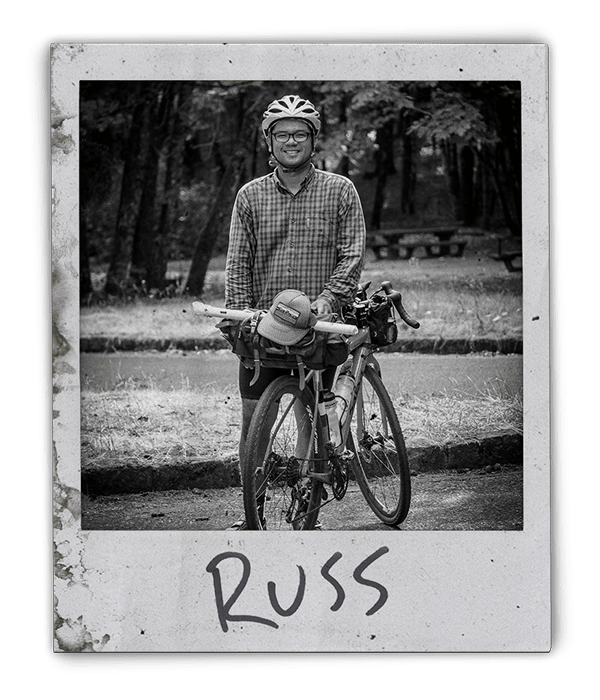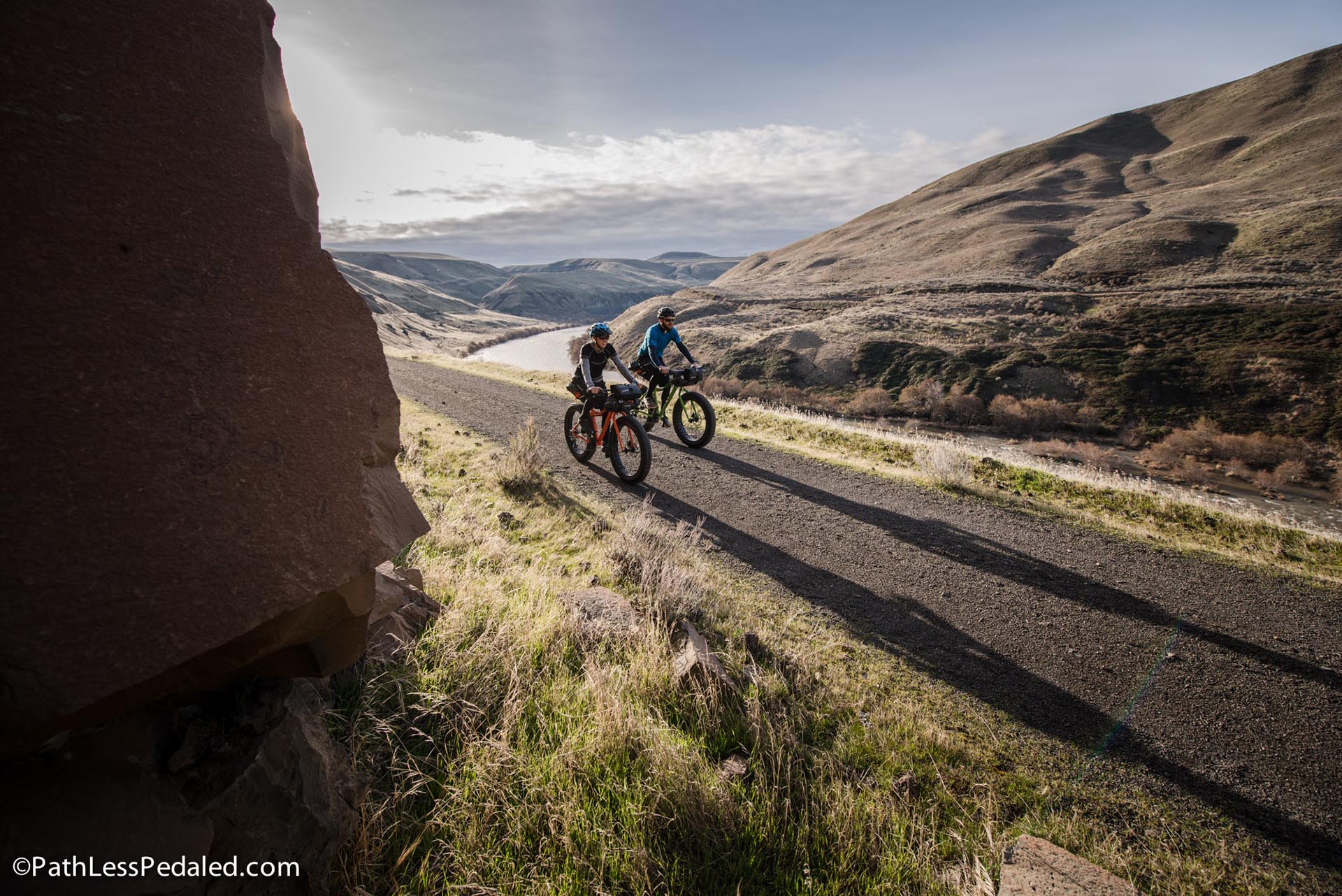Bikepacking vs. Bike Touring

If you’re new to the world of camping by bike, the terms “bike touring” and “bikepacking” might be a little confusing. What’s the difference? What are the advantages of one packing system over the other? Which system should you commit to?
Bike touring is a broad category that encompasses all forms of loading up camping gear on your bike and traveling. Bikepacking is a type of bike touring which is more focused on unpaved surfaces (singletrack, gravel roads, etc.,) and the bags are optimized to address those specific challenges. Another way to look at it is that all “bikepacking” is considered “bike touring”, but not all bike touring is bikepacking. The same way all IPAs are beers, but not all beers are IPAs. Mmmm. Beer.
Bike Touring (Rack and Pannier)
Bike touring in the traditional sense happens mostly on-road routes like the iconic TransAm route mapped out by Adventure Cycling in the 1970s. The surfaces are usually some sort of road (paved or unpaved) and the packing system consists of racks and panniers. To accommodate racks, touring bikes have braze-ons and eyelets to mount the racks on. Panniers attach to the tubing of the rack with either a simple hook and bungee system or more adjustable hardware that can be found on bags by the brands Ortlieb and Arkel.
The biggest advantages of the rack and pannier system is interior volume, cost and fit especially for shorter riders. For example, a single pair of Ortlieb rear panniers has a capacity of 70L and costs $250 MSRP (approx $3.50 per liter of volume). Whereas a large seat bag like the Revelate Viscacha has a max volume of 14L and costs $130 MSRP (approx $9.30 per liter of volume).
Because of the larger volume, packing with a rack and pannier system is really easy. There is less of a need to carefully place things in specific bags in a specific order. In addition, the top of the rack also acts a convenient place to strap things when you need added capacity.
If you are someone that tends to overpack or has bulky gear or need the volume to carry supplies over long stretches, the rack and pannier system is probably for you.
A traditional rack and pannier system also works great for shorter riders that don’t have the clearance to run a bikepacking style seat bag because of insufficient tire clearance between the bottom of the seat bag and the top of the tire and because the interior space for a frame bag is laughably small or non-existent.
Cons of a rack and pannier system are the tendency to overpack and the potential for hardware failure on rough terrain. Nature abhors a vacuum and the added volume panniers provide beckon you to fill them. Also, whenever there are more moving parts in a system there is a greater likelihood of failure. Bolts can come loose or shear. Panniers can jump off racks or clips can break off. That said, it is really dependent on load weight and terrain. If you are riding reasonable roads with reasonable weight, the rack and pannier should serve you well.
PROS:
-Initial costs
-Volume capacity
-Works for shorter riders
CONS:
-Weight
-Tendency to overpack
-Possibility of hardware failure
Bikepacking (Rackless Bags)
Interview with Eric Parsons of Revelate Design Works
Bikepacking Bags Playlist
Bikepacking generally occurs on non paved surfaces on routes like the Great Divide, Arizona Trail, Colorado Trail or other mapped routes. Bikepacking bags are optimized for crossing rough terrain like singletrack, gravel roads, snow, sand or where no paths exist and you have to carry your bike. This is accomplished by reducing as much weight as possible, packing light and keeping a minimal form factor.
Bikepacking bags attach to your bike typically via a system of straps and velcro, although some seat bags have started to incorporate hardware to prevent bag wag. This allows any bike from a road or full suspension bike to be used with bikepacking bags since it doesn’t rely on braze-ons or eyelets to attach hardware too.
Some of the biggest advantages of a bikepacking system is that because of their smaller carrying capacity, loads are considerably lighter. This adds to a more enjoyable riding experience on the bike and also makes it easier to portage a bike over rough terrain. Generally speaking, you can cover more ground efficiently because you are not carrying as much weight. This is one reason that this style of packing dominates bikepacking races. Another big advantage is there are less things to break. There are no bolts to shear and no hooks to crack. If something does break like a strap or a buckle, it is typically field repairable.
One of the biggest hurdles to bikepacking bags is the packing itself. Whereas bike touring systems usually distributes the load between 2 to 4 panniers, bikepacking requires a whole fleet of various types of smaller bags. The typical bikepacking setup includes a seat bag for, a handlebar bar roll, a frame bag, various top tube bags, stem bags, fork mounted racks and stuff sacks and even potentially a backpack.
This is further complicated by the fact that your potential carrying capacity fluctuates with your frame size. Larger frames have more generous clearances and can use larger frame bags and seat bags. Smaller frames can only use minuscule frame bags and may potentially not be able to use a seat bag at all because of tire rub.
Another, often unspoken, challenge of bikepacking is the cost. To purchase a complete system of bikepacking bags can set you back anywhere from $400 to $600. And, that is only the beginning. Because of smaller volume capacity, it necessitates more packable ultralight gear which in turn costs more money.
All that said, the liberty of the terrain that a light bikepacking setup can help you explore is amazing. There are some trips we have done where a bikepacking setup was definitely the better option. Instead of worrying if our rack bolts were going to shear off on a rough descent, we could let the brakes go a little more and enjoy the ride. We also have appreciated bikepacking bags on steep rocky ascents where there was the occasional bike pushing involved.
PROS:
-Better ride experience
-Lightweight and maneuverable
-Suited for trails and rougher terrain
CONS:
-Limited storage capacity
-Shorter riders are at a disadvantage with bag capacity
-COST!
Other Options
Front Load Packing
Of course, bike touring doesn't have to be an either/or proposition. Our current favorite style of packing is to borrow aspects from both styles. We use smaller front panniers, a handlebar roll, frame bag, and seat bag. A setup like this gives you some more capacity than a pure bikepacking setup, yet also encourages you to pack much lighter than a traditional 4 pannier bike touring setup.
Another popular option is to use a front basket like the Wald 137. Affectionately known as #basketpacking on Instagram, it has the advantage of being affordable with good capacity and frees you to use any kind of bag you want in the basket.
Which is Right For You?
Simple Overnight Packing Setup
The first question you should ask yourself is what kind of terrain are you going to be riding on? If you plan to tour on roads (paved or unpaved) a rack and pannier would be more than sufficient. If you plan to tour on singletrack and rough surfaces that may include some hike a bike, a bikepacking setup would be the better option.
If you are completely new to camping by bike but already bike commute with a rack and pannier, the best course of action might be to just use what you have and see if you like it or to incorporate a bikepacking bag with your rack and pannier system. The upfront cost of a pure bikepacking system can be daunting and it makes sense to try it out before making the big financial commitment. If you are already a seasoned hiker and can travel minimally and already own ultralight gear, then the leap into bikepacking will be exponentially easier.
In our experience, both methods of packing have their distinct pros and cons and neither is categorically better than the other and we often switch between systems depending on the ride. Our biggest piece of advice: don’t let existential gear lust prevent you from bike touring. If you want to tour, then tour! Use what you’ve got and upgrade along the way!



